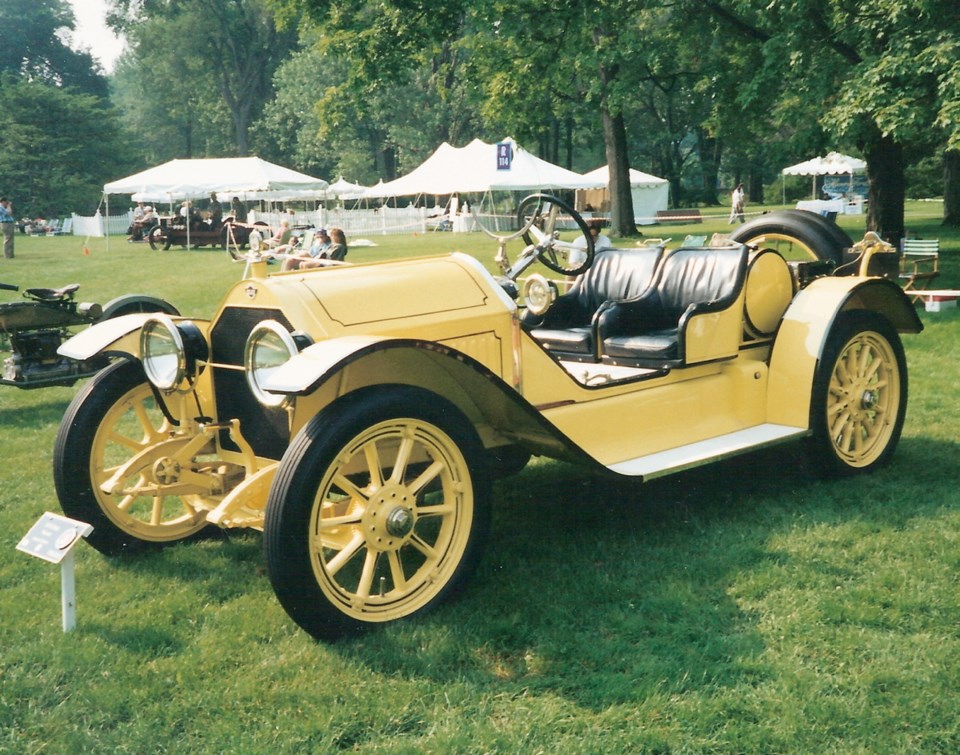The Stutz Bearcat name had a touch of magic, conjuring up as it did images of raccoon coats, brisk fall afternoons and rich young blades whisking their beautiful dates to the football game. In a later era, one could imagine another car named after an animal, the Jaguar XK120, filling the same role.
Harry C. Stutz was an accidental automobile manufacturer. His intention was really to enter the automotive component business, and in 1910 he established the Stutz Auto Parts Co. in Indianapolis to produce a combination transmission-differential he had developed.
To prove his new product’s robustness, Stutz built a car fitted with his new transaxle. His shakedown test was a severe one; he entered his car in the first Indianapolis 500 race in 1911.
To Stutz’s delight, driver Gil Anderson finished 11th, averaging 110 km/h, an outstanding showing for a new, untried car.
Prompted by the good publicity, Stutz changed his plan and established Ideal Motor Car Co. to manufacture what he called “the car that made good in a day.” He renamed it Stutz Motor Car Co. in 1913.
The best known of all Stutzes, the Bearcat, was introduced in 1912 to do battle with its fiercest competitor and archrival, the Mercer Raceabout.
The Bearcat had a huge four-cylinder T-head (inlet valves in one side of the cylinder block and exhausts in the other), 50-horsepower, 6.3-litre (389 cu in.) Wisconsin engine.
Those early Bearcats were starkness personified — just fenders, a “doghouse” hood, two seats, a barrel-like fuel tank, a real trunk and a couple of spare tires. The driver had a monocle windshield, but the passenger got goggles or no protection at all.
Despite its minimal bodywork, the Bearcat weighed a hefty 2,041 kilograms. Its wheelbase was 3,048 millimetres, and its giant 4.50-by-34 inch tires gave it a stance 1,219 mm high at the hood.
Performance figures for cars of that vintage are rare, but in this case, we have some. Mechanix Illustrated’s intrepid car tester Tom McCahill drove a mint-condition 1914 Stutz Bearcat in September 1951. He reported a top speed of almost 130 km/h, and zero to 100 km/h in 29.2 seconds.
He also noted that Bearcats required rugged drivers. “They would go wherever you headed them, and keep going, but you still needed lots of arm moxie to turn them. And plenty of beef to throw out the clutch and push down the brake. You couldn’t ride those old-time clutches, Buster. It takes a good 75 to 100 pounds of pressure to throw them out.” And the two-wheel mechanical brakes, said the understated McCahill, took “enough pressure to squash a rock.”
Harry Stutz continued entering competitions, with the Indianapolis 500 being a sentimental favourite in which Stutzes finished third in 1913 and in 1915. The “White Squadron” racing team, white-clad drivers in white Stutzes, became the scourge of America’s racing circuits during the 19-teens.
Stutz’s exploits weren’t confined to the track. When a 1916 Bearcat owner brought his car to his New York dealer complaining that the Mercers were trouncing him, the Stutz public relations department smelled an opportunity.
They fitted the car’s engine to another Stutz, which was then driven coast-to-coast by long-distance driver Erwin George Baker who flogged it across the continent in 11 days, 71Ú2 hours.
Baker established a new transcontinental speed record for Stutz and a new nickname for himself, “Cannonball Baker.” He liked it so much he had it copyrighted. He became the premier cross-country record driver, eventually setting 143 long-distance marks.
Founder Harry Stutz lost control of the company through stock manipulations and departed in 1919. The Bearcat continued but sales declined, and by 1924 the Bearcat name was dropped, although it would return later.
Stutz continued building some high-performance cars, including the Black Hawk speedster, which was American Automobile Association racing champion in 1927. In 1928, a Black Hawk finished second in the Le Mans, France, 24-hour race, the best American car showing until Ford’s GT40 won it in 1966.
In the early 1930s, Stutz was unable to afford a huge multi-cylinder engine as did the Cadillac, Packard and Marmon V-12s and V-16s. Instead, it fitted double overhead camshafts and four-valve cylinders to its Vertical Eight to create the fabulous 156 horsepower, 32-valve Stutz DV-32.
The DV-32 was guaranteed to exceed 160 km/h. A shorter version, the Super Bearcat with a 2,946-mm wheelbase rather than the standard Bearcat’s 3,416 mm, was even faster.
The Great Depression finished Stutz as it did so many others. Production ceased in 1934, but the Stutz Bearcat remains the supreme embodiment of an earlier, more swashbuckling era.



